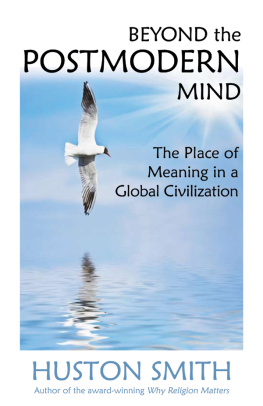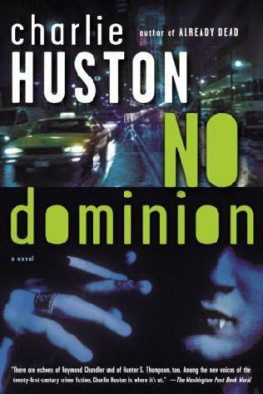The publisher gratefully acknowledges the generous support of the Humanities Endowment Fund of the University of California Press Foundation.
The Huston Smith
Reader

Edited, with an Introduction, by
Jeffery Paine

UNIVERSITY OF CALIFORNIA PRESS
Berkeley Los Angeles London
University of California Press, one of the most distinguished university presses in the United States, enriches lives around the world by advancing scholarship in the humanities, social sciences, and natural sciences. Its activities are supported by the UC Press Foundation and by philanthropic contributions from individuals and institutions. For more information, visit www.ucpress.edu.
University of California Press
Berkeley and Los Angeles, California
University of California Press, ltd.
London, England
2012 by Huston Smith
For acknowledgment of previous publication, please see credits, page 255.
Library of Congress Cataloging-in-Publication Data
Smith, Huston.
The Huston Smith reader / edited with an introduction by Jeffery Paine.
p. cm.
Includes bibliographical references.
ISBN 978-0-520-27022-0 (cloth : alk. paper)
1. Religion. 2. Religions. I. Paine, Jeffery, 1944 II. Title.
BL27.S39 2012
200dc23 2011030335
Manufactured in the United States of America
21 20 19 18 17 16 15 14 13 12
10 9 8 7 6 5 4 3 2 1
In keeping with a commitment to support environmentally responsible and sustainable printing practices, UC Press has printed this book on Rolland Enviro100, a 100% post-consumer fiber paper that is FSC certified, deinked, processed chlorine-free, and manufactured with renewable biogas energy. It is acid-free and EcoLogo certified.
PREVIEW: THE BOOK NOW IN YOUR HANDS
The contents of this volume are easy to describe: they are the best essays and excerpts from Huston Smith's many books, chosen for their relevance and resonance today. In his Welcome Huston observes how most Readers have a random, meandering character, but this one is, or hopes to be, more than the sum of its parts.
For here, as one selection succeeds another, something about the elusive nature of religion itself is revealed. An analogy to language may be useful. A second language allows you to begin to seebeyond the idiosyncrasies of your native English or Mandarinwhat language itself is and does. Likewise when you encounter sympathetically a second religion: you begin to detect the larger unstated background, the sorrowing and the goodness, the meaninglessness and the ingenuity, the humanness in the universe, out of which all religions arise. This Reader attempts to give such a bird's-eye view of the whole shebang.
In its organization the book follows a schemata Huston used when he investigated reality or selfhood, ascending and descending level by level through the several worlds we live in simultaneously. The book begins personally, with Huston confiding his personal experience. From there it widens out into the immediate world, the various kinds of everyday circumstances, surrounding him (and us). The third section ventures further (or deeper), into the sphere of religions itself, which suffuses mundane existence with understanding and, possibly, tools for enhancing it. In the penultimate section, Huston situates even religious experiences in a larger frameworkthe Big Picture or unconditional worldviewwhere things finite yield a more infinite aspect. This Reader thus makes, in a sense, a little tour from Berkeley, California, to the ends of the cosmos. Yet it might be truer to say that it goes nowhere at all: each sphere of life, and each section in the Reader, contains a subtle reflection of the others: and so we end with Huston personally again, as he tells about being ninety and encountering God.
Bookkeeping. The one of Huston's books not excerpted here is the one for which he is most famous. The World's Religions reads best as a whole, and with three million copies in print, you can, if you have not already read it, easily acquire a copy. Some of the selections here have been lightly edited, to avoid repeating material already discussed in another essay or dated, now-obscure references. Only a few pieces are particularly challenging (notably The Levels of Reality and The Levels of Selfhood), but they seem worth it. Writing about religion can at times be complex and difficult, Huston observed and quoted C. S. Lewis, as difficult as modern physics, and for the same reason. Huston is overall a pleasing and accessible stylist, though, and most chapters here provide that literary pleasure.
Once, while delivering a public lecture, Huston could find no chalk to make his point on the blackboard. Never mind, he said, I'll write it in air and you will see it vividly. This volume records what Huston said on those better occasions when he had, as it were, a blackboard and chalk in hand.
INTRODUCTION: GRAND TOUR OF ALL THE WORLDS
Who is Huston Smith? The answer seems straightforward. He is a retired college professor in Berkeley who taught at various universities, and he wrote books, one of which sold incredibly well. oh yes, there's one thing more. Huston Smith did something that nobody, no one else in the history of the world, had done or even had thought to do before.
What has Huston done that no one else had done? Simply this: he was a practitioner of practically all the major world's religions, a unique feat in the annals of spirituality. There used to be on official forms a box where you had to write in your religion; Huston would have had a hard time squeezing into that small space Judeo-Christianity, Hinduism, Buddhism, and Islam.
In the beginning: Huston was born in 1919 to missionary parents in China. To that little boy Christianity was the only religion there was, identical with faith, synonymous with spirituality itself. Next: as a young man Huston met a Hindu swami in St. Louisthe only true saint he feels he ever metand the scales, as it were, fell from his eyes. Before he had been like the bumpkin who thinks his languageEnglish, Inuit, or whateveris the only language there is. When Huston learned there were other languages, or rather other religions, other worlds opened for him, and for the next decade he practiced Hinduism. In middle age Huston discovered Hinduism's stepchild, Buddhism. He had not suspected there could be such a thing: a spiritual path rooted not in faith but in experience, and at the root of experience was not Original Sin to be overcome but an innate perfection to be realized. For ten years Huston sought out Buddhist teachers and gurus, stayed in a Zen monastery in Kyoto, and strove for satori, or enlightenment. Huston had by then acquired the knack of knocking on unfamiliar religious doors, and it felt natural to now enter into Islam. He studied the Koran, joined a tariqa, or secret Muslim fraternity, prayed facing Mecca five times a day, and enjoyed a devotee's personal relation to Allah. His experience of polymorphous spirituality led him to write The World's Religions, which has sold nearly three million copies, but Huston did not pursue the different religions in order to write a book about them. He had no checklist to go down, faith by faith. In moving from Christianity to Hinduism and from Hinduism to Buddhism and from there to Islam, he was also exploring unexamined parts of himself. He decided to show others, by writing and teaching, how to do similarly, how to have the greatest inward adventure of all.
















